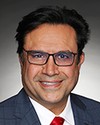At this point, many of the people who are not vaccinated are in small groups, smaller communities, and I think that if we're really going to get those people to get vaccinated, we have to reach out to them with very specific programs. Whether it be a religious group or a cultural group, you have to get in there and give them the information they need to make an informed decision. It's a ground game at this point.
Earlier on, we were always a little handicapped by patient privacy. If I could have shown people what I saw on imaging, if I could have talked to people directly about cases, I have no doubt in my mind that many people would have run out the next day and gotten vaccinated. I saw things that I have never seen in my career—and I've been doing this for a couple of decades now. I saw people on ventilators with torn-out lungs. That's not something that you see normally.
This has been an incredibly serious illness, but because of patient confidentiality, because of patient privacy, we're not able to speak freely about the impact on patients. I wonder whether, if we had had some way of getting around that, we would have been able to better share the seriousness of the illness. But it's always a balance.




